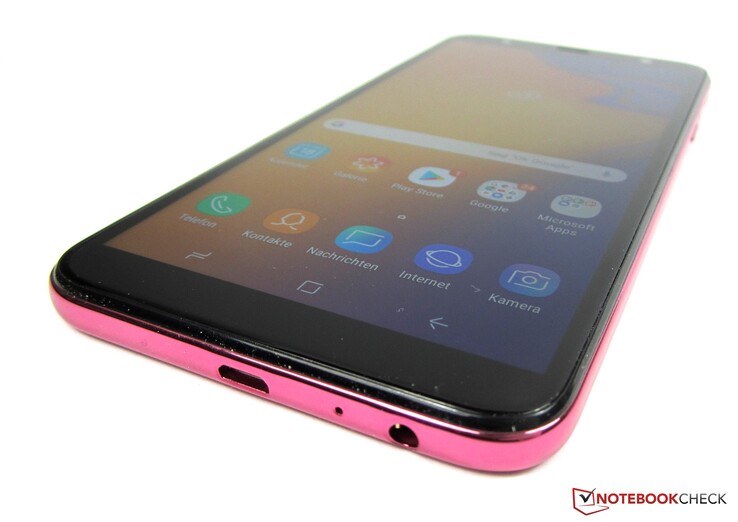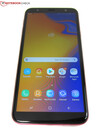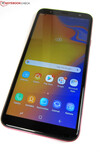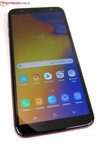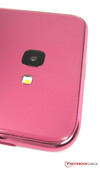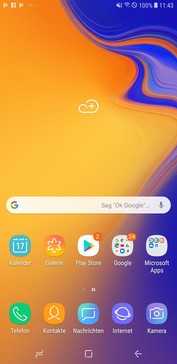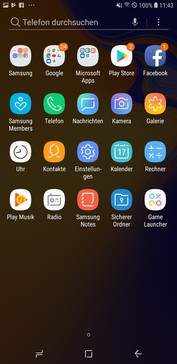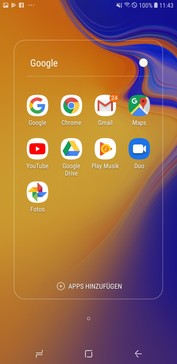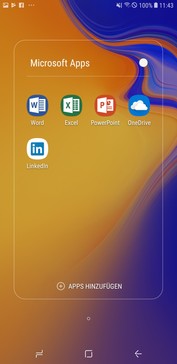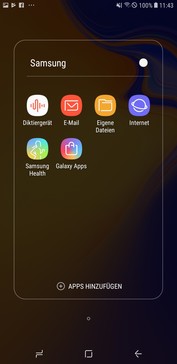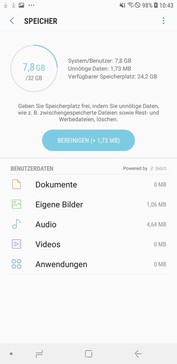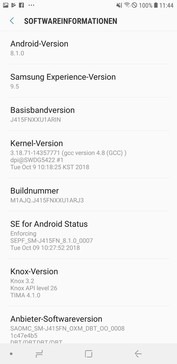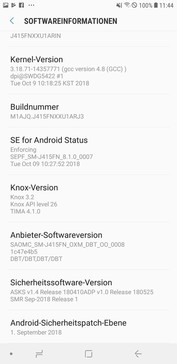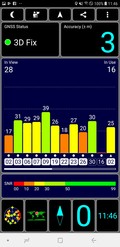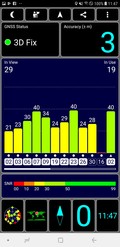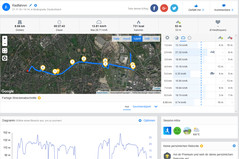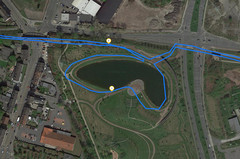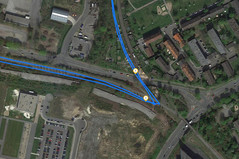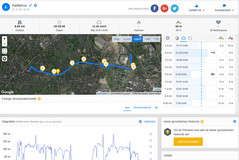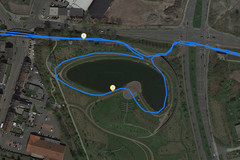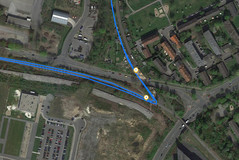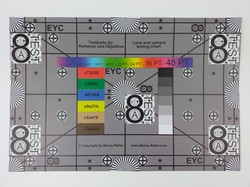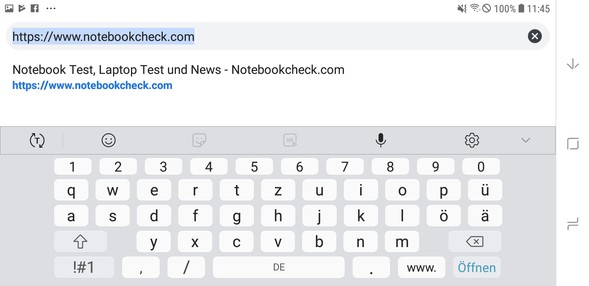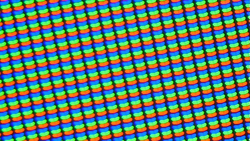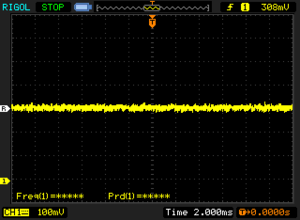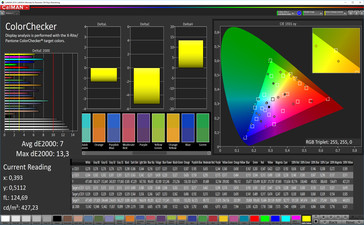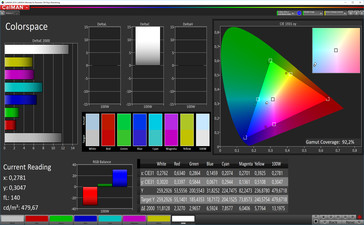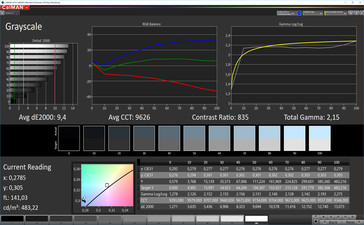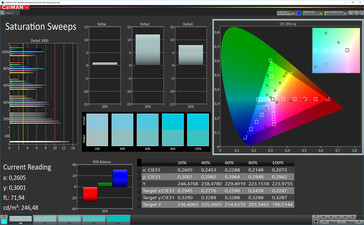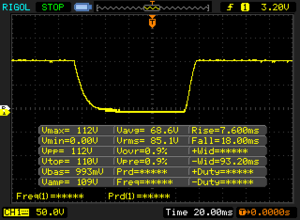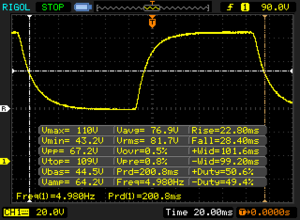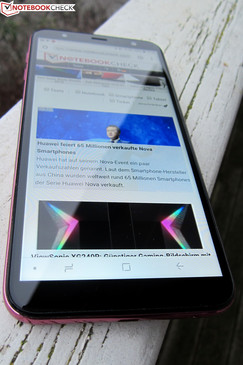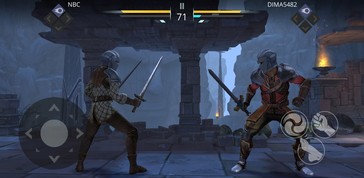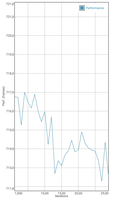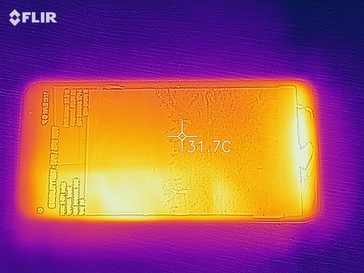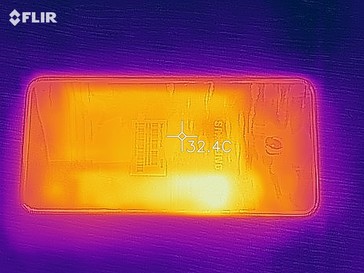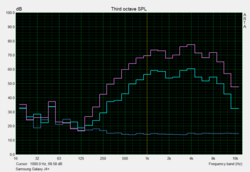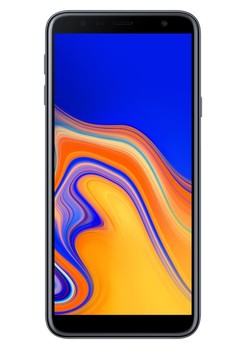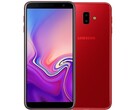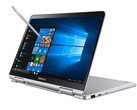Samsung Galaxy J4 Plus (2018) Smartphone Review
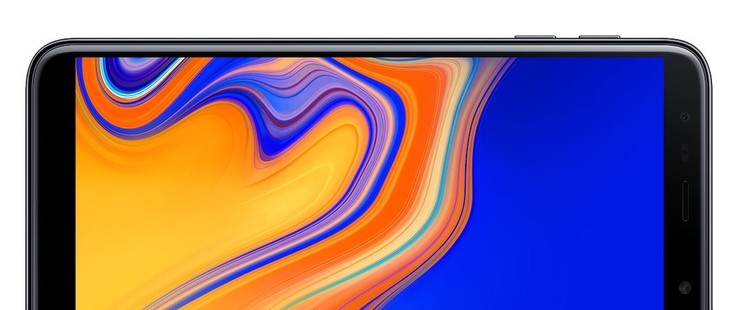
Samsung has expanded its range of smartphones with new entry-level devices. The company’s cheapest new smartphone is the Galaxy J4 Plus (2018), which launched at 189 Euros (~US$215). The J4 Plus (2018) packs in plenty for the money though. Samsung has equipped the device with a 6-inch IPS display that runs at a native 1480x720 resolution, which corresponds to a slim 18.5:9 aspect ratio.
Moreover, the J4 Plus (2018) currently ships with Android 8.1 Oreo, while it is also equipped with a 13-MP camera, 2 GB RAM, 32 GB of internal storage, and dual-SIM functionality. The Qualcomm Snapdragon 425 SoC powers the J4 Plus (2018) and integrates a Qualcomm Adreno 308 GPU. Both the CPU and GPU should be powerful enough for most apps and games, although the SoC is almost three years old at the time of writing.
The J4 Plus (2018) has no fingerprint sensor, which is a rarity for a smartphone released in 2018. The Galaxy J6 Plus, by contrast, has a fingerprint sensor and dual rear-facing cameras, the latter of which the J4 Plus also lacks. The Galaxy J6 Plus is Samsung’s second new budget device and is mostly the same as its cheaper sibling besides having 1 GB more RAM and the two aforementioned features. Please see here for an overview of the differences between the Galaxy J4 Plus (2018) and the Galaxy J6 Plus. The article is in German, but many of the terms should be understandable for an English speaker.
We have chosen to compare the Galaxy J4 Plus (2018) against other budget devices to assess its strengths and weaknesses. Our comparison devices include the BQ Aquaris C, Huawei Y6 2018, LG K11, Motorola Moto E5 Plus, Nokia 2.1, and Xiaomi Redmi 6.
Case
The Galaxy J4 Plus (2018) does not look like an entry-level smartphone in our opinion. Firstly, it has a 6-inch display, rounded corners, and a glass back case. In short, the budget price tag belies its premium design. The back glass has a glossy finish though, which proved to be a fingerprint magnet during our tests and makes the device feel unnervingly slippery in our hands.
Our test device is well-made and is just as good as the more-expensive Galaxy A and Galaxy S series in principle. We can twist our test device though, but the case does not emit any creaking or cracking sounds when we do so. Moreover, we could not get the display to deform by applying pressure directly to it, which is often a structural issue of many budget smartphones.
The J4 Plus (2018) is larger and heavier than most of our comparison devices. It is the second-thinnest at 7.9 mm though and is only 0.1 mm thicker than the Huawei Y6 2018.
Samsung currently sells the J4 Plus (2018) in black, gold and pink, the latter of which is the colour of our test device.
Connectivity
Many smartphones advertise dual-SIM functionality, but the marketing is often disingenuous. Even premium devices like the Sony Xperia XZ3 are ‘dual-SIM’ and support microSD card expansion, but they only have two card slots, which means that you can choose dual-SIM functionality or microSD card expansion but not both.
By contrast, the J4 Plus (2018) has three card slots and supports up to 512-GB microSD cards. The device can read cards that are formatted in exFAT too. Moreover, the J4 Plus (2018) can store apps and data on external storage, which is useful if you run out of space on the internal storage. The J4 Plus (2018) has 32 GB of internal storage, but only around 24 GB is free to use, with the remaining 8 GB used up by the OS and its partitions.
Samsung has also equipped the device with an NFC chip, which is not always found in budget smartphones. Unfortunately, the device lacks a fingerprint sensor and has a micro-USB port rather than a USB Type-C port, which is reversible and generally can charge devices faster than micro-USB connections can. The J4 Plus (2018) supports USB On-The-Go (OTG) though, should you wish to connect external peripherals like a keyboard and mouse.
Software
The J4 Plus (2018) ships with Android 8.1 Oreo, while our test device has September 1, 2018 Android Security patches installed, which are almost four months old at the time of writing.
The device runs the Samsung Experience UI, which is the company’s customised version of Android. Our test device runs Samsung Experience 9.5, which differs slightly from stock Android. Principally, Samsung has used a different icon pack, reorganised the Settings menu and added some battery-saving features. Most people who are familiar with Android should not need much time to get used to Samsung Experience.
Our test device also has plenty of preinstalled apps from Google, Microsoft and Samsung. We have included screenshots below of all the apps that are included by default. Many preinstalled apps can be uninstalled or disabled, but others like LinkedIn cannot be, which is frustrating.
Communication & GPS
The J4 Plus (2018) can connect to GSM, 3G and 4G networks. The device supports LTE Cat.4 for up to 150 Mb/s download speeds and can connect to a wide range of LTE bands that are common in Central Europe. We had no issues connecting to LTE networks on the rural Vodafone network during our tests.
The device also supports NFC, Bluetooth 4.2 and modern Wi-Fi standards up to IEEE 802.11 n, which limits it to only 2.4 GHz Wi-Fi networks. Our test device achieved moderate Wi-Fi transfer speeds when tested with our Linksys EA8500 reference router. The J4 Plus (2018) averaged less than 50 Mb/s in both iperf3 (Client) Wi-Fi tests, which puts it below most of our comparison devices. Moreover, our test device struggled to maintain its Wi-Fi speed, which often caused transfer speeds to drop to around 20 Mb/s. Only the Moto E5 Plus achieved slower transfer speeds in both tests of our comparison devices, but overall the J4 Plus (2018) finished on par with its competitors. The BQ Aquaris C is the outlier here with over 200 Mb/s transfer speeds in both tests.
The Galaxy J4 Plus (2018) uses BeiDou, GLONASS, GPS and SBAS for location services. Our test device can locate us with up to three metres accuracy even when tested inside of buildings, which is on par with some flagship devices.
We also took our test device on a bike ride to compare its navigation skills against the Garmin Edge 500, a professional navigation system. The J4 (2018) performed remarkably well for its price, with its recorded route differing by only 20 metres compared to the Garmin’s. Our test device lacks the fine location accuracy that the Garmin has, but overall the Galaxy J4 Plus (2018) is precise enough for most navigation tasks.
Telephone Features & Call Quality
Samsung currently only sells the dual-SIM version of the J4 Plus (2018) on its website, which carries the DUOS branding. The device can assign either SIM as the default for voice calls, messages and data services.
Our test device has decent call quality, with voices sounding clear and undistorted when making calls using the earpiece or over speakerphone. We noticed that the microphone would pick up background noise from time to time though, although not intrusively so.
Cameras
The J4 Plus (2018) has a single rear-facing camera, which is one fewer than how many the J6 Plus has. The J4 Plus (2018) has a 13 MP rear-facing sensor with an f/1.9 aperture that can capture photos in up to 4128x3096 resolution and shoots videos in up to 1920x1080 at 30 FPS. By contrast, the front-facing camera is a 5 MP sensor with an f/2.2 aperture. Both cameras are supported by an LED flash.
The default camera app has numerous options including an HDR function, multiple camera modes and a timer. The app has AR Sticker, Beauty, Panorama and Pro modes, the latter of which includes options to manually set the ISO, exposure level and the white balance should you wish to do so. Conveniently, the shutter button can be moved freely, which improves usability. Unfortunately, the shutter button is fixed when using the front-facing camera, which also lacks the image effects and stickers that are available when using the rear-facing camera.
The J4 Plus (2018) takes passable photos, but it cannot compete with its more expensive competitors. In isolation, the rear-facing camera takes vivid shots with bright colours in daylight, as demonstrated by scenes 1 and 2. However, photos lack detail even in perfect conditions, while the camera algorithms overly sharpen objects to the point where the scene starts looking unrealistic.
The rear-facing camera predictably struggles more in low-light conditions, despite Samsung claiming “Quality photos, even in low-light” on its J4 Plus (2018) product page. Photos taken in low light are underexposed and lack detail, as scene 3 demonstrates.
We also subjected the J4 Plus (2018) to further camera tests under controlled lighting conditions. We check the quality of colour reproduction with X-Rite ColorChecker Passport and the image sharpness with our test chart.
The J4 Plus (2018) reproduces colours too strongly compared to reference colours like many smartphones, but the rear-facing camera’s colour accuracy is better than most. However, our review device struggled in our test chart assessment, in which it could not capture our test chart sharply.
Accessories & Warranty
Samsung includes a USB Type-A to Micro-USB cable in the box along with a 5 V/1 A charger, a set of headphones, a SIM tool and a quick-start guide. The company does not sell any J4 Plus (2018) specific accessories on its website.
The J4 Plus (2018) comes with 24 months manufacturer’s warranty. The battery is only covered for 12 months though, while its accessories have just six months warranty. Please see our Guarantees, Return policies and Warranties article for country-specific information.
Input Devices & Operation
The touchscreen on our test device recognises up to five fingers simultaneously and generally responds well to commands. The same applies to the accelerometer, which converted screen rotations with a slight delay during our tests. The physical buttons have minimal play in their housings and have clear pressure points. The buttons respond with a pleasing clicking sound when pressed too.
Samsung has dispensed with a fingerprint sensor on the J4 Plus (2018). The device can be unlocked with a pattern, PIN or with a face, which all worked reliably throughout testing. Please keep in mind that the facial unlocking is not as secure as Apple FaceID or any other 3D facial authentication solutions.
Display
Samsung has equipped the J4 Plus (2018) with a 6-inch IPS panel that operates at a native 1480x720 resolution. The display has an 18.5:9 aspect ratio and achieved an average maximum brightness of 548.9 cd/m² according to X-Rite i1Pro 2, which is brighter than most of our comparison devices. The BQ Aquaris C is our only comparison device to achieve a brighter value, with the remaining devices generally having 100 cd/m² darker displays than the J4 Plus (2018).
Our test device achieved a slightly darker maximum luminosity of 548 cd/m² according to the more realistic APL50 test, which is still a respectable value. Maximum luminosity drops to a less impressive 484 cd/m² when the ambient light sensor is disabled though.
| |||||||||||||||||||||||||
Brightness Distribution: 89 %
Center on Battery: 558 cd/m²
Contrast: 979:1 (Black: 0.57 cd/m²)
ΔE ColorChecker Calman: 7 | ∀{0.5-29.43 Ø4.77}
ΔE Greyscale Calman: 9.4 | ∀{0.09-98 Ø5}
92.2% sRGB (Calman 2D)
Gamma: 2.15
CCT: 9626 K
| Samsung Galaxy J4 Plus 2018 IPS, 1480x720, 6" | BQ Aquaris C IPS, 1440x720, 5.5" | Huawei Y6 2018 IPS, 1440x720, 5.7" | LG K11 IPS, 1280x720, 5.3" | Nokia 2.1 IPS, 1280x720, 5.5" | Motorola Moto E5 Plus IPS, 1440x720, 6" | Xiaomi Redmi 6 IPS, 1440x720, 5.5" | |
|---|---|---|---|---|---|---|---|
| Screen | 19% | 12% | -21% | 10% | 1% | 6% | |
| Brightness middle (cd/m²) | 558 | 623 12% | 483 -13% | 394 -29% | 338 -39% | 518 -7% | 373 -33% |
| Brightness (cd/m²) | 549 | 608 11% | 460 -16% | 385 -30% | 327 -40% | 481 -12% | 361 -34% |
| Brightness Distribution (%) | 89 | 91 2% | 88 -1% | 93 4% | 82 -8% | 87 -2% | 94 6% |
| Black Level * (cd/m²) | 0.57 | 0.61 -7% | 0.4 30% | 0.66 -16% | 0.27 53% | 0.85 -49% | 0.53 7% |
| Contrast (:1) | 979 | 1021 4% | 1208 23% | 597 -39% | 1252 28% | 609 -38% | 704 -28% |
| Colorchecker dE 2000 * | 7 | 4.5 36% | 5.8 17% | 8.2 -17% | 5.36 23% | 4.47 36% | 4.22 40% |
| Colorchecker dE 2000 max. * | 13.3 | 7.33 45% | 12.6 5% | 21.5 -62% | 9.77 27% | 8.04 40% | 10.14 24% |
| Greyscale dE 2000 * | 9.4 | 4.8 49% | 5 47% | 7.5 20% | 6.2 34% | 5.4 43% | 3.3 65% |
| Gamma | 2.15 102% | 2.596 85% | 2.6 85% | 2.6 85% | 2.345 94% | 2.318 95% | 2.321 95% |
| CCT | 9626 68% | 7557 86% | 7709 84% | 7581 86% | 8460 77% | 7134 91% | 6862 95% |
| Colorchecker dE 2000 calibrated * | 4.42 |
* ... smaller is better
Screen Flickering / PWM (Pulse-Width Modulation)
| Screen flickering / PWM not detected | |||
In comparison: 53 % of all tested devices do not use PWM to dim the display. If PWM was detected, an average of 8081 (minimum: 5 - maximum: 343500) Hz was measured. | |||
We subjected our test device to further tests with the CalMAN analysis software and a spectrophotometer, which revealed that the display has a 979:1 contrast ratio, which is considerably lower than what the Huawei Y6 2018 and Nokia 2.1 achieve. The J4 Plus (2018) has an underwhelming contrast ratio because of its 0.57 cd/m² black value, which is much higher than our comparison devices with higher contrast ratios.
Moreover, the display has a 9,626 K colour temperature, which is much higher than the ideal temperature. Our test device has high DeltaE grey and colour deviations too, which means that the display is comparatively colour inaccurate. The display also has a slight blue tint to it, which is disappointing.
Display Response Times
| ↔ Response Time Black to White | ||
|---|---|---|
| 25.6 ms ... rise ↗ and fall ↘ combined | ↗ 7.6 ms rise | |
| ↘ 18 ms fall | ||
| The screen shows relatively slow response rates in our tests and may be too slow for gamers. In comparison, all tested devices range from 0.1 (minimum) to 240 (maximum) ms. » 60 % of all devices are better. This means that the measured response time is worse than the average of all tested devices (20.2 ms). | ||
| ↔ Response Time 50% Grey to 80% Grey | ||
| 51.2 ms ... rise ↗ and fall ↘ combined | ↗ 22.8 ms rise | |
| ↘ 28.4 ms fall | ||
| The screen shows slow response rates in our tests and will be unsatisfactory for gamers. In comparison, all tested devices range from 0.165 (minimum) to 636 (maximum) ms. » 87 % of all devices are better. This means that the measured response time is worse than the average of all tested devices (31.6 ms). | ||
The J4 Plus (2018) is easy to use outside thanks to its bright display, although you may struggle to read the screen in direct sunlight. The IPS display also has strong viewing angles. We did not notice brightness or colour distortions even at acute viewing angles, so the J4 Plus (2018) should remain usable at practically any angle.
Performance
The Qualcomm Snapdragon 425 SoC has been around for almost three years, which makes it old in the fast-moving world of smartphone tech. The quad-core processor still performs comparatively well though by today's standards.
The Galaxy J4 Plus (2018) performed well in our benchmarks, primarily because many of our comparison devices are equipped with the same SoC. Our test device is on par with the MediaTek MT6750-powered LG K11 too. In daily use, the J4 Plus (2018) generally feels snappy, although we did notice occasional short delays when switching between apps or when we subjected it to sustained load.
However, the ageing SoC would not run some current benchmarks like 3DMark Sling Shot Extreme and GFXBench from version 3.1 upwards. The integrated Adreno 308 GPU is a weak point of the SoC as it is not powerful enough to run many modern games.
| GFXBench 3.1 | |
| on screen Manhattan ES 3.1 Onscreen (sort by value) | |
| Samsung Galaxy J4 Plus 2018 | |
| Huawei Y6 2018 | |
| LG K11 | |
| Nokia 2.1 | |
| Xiaomi Redmi 6 | |
| Average of class Smartphone (11 - 166, n=155, last 2 years) | |
| 1920x1080 Manhattan ES 3.1 Offscreen (sort by value) | |
| Samsung Galaxy J4 Plus 2018 | |
| Huawei Y6 2018 | |
| LG K11 | |
| Nokia 2.1 | |
| Xiaomi Redmi 6 | |
| Average of class Smartphone (8.4 - 413, n=154, last 2 years) | |
| GFXBench | |
| on screen Car Chase Onscreen (sort by value) | |
| Samsung Galaxy J4 Plus 2018 | |
| Huawei Y6 2018 | |
| LG K11 | |
| Nokia 2.1 | |
| Xiaomi Redmi 6 | |
| Average of class Smartphone (5.5 - 154, n=157, last 2 years) | |
| 1920x1080 Car Chase Offscreen (sort by value) | |
| Samsung Galaxy J4 Plus 2018 | |
| Huawei Y6 2018 | |
| LG K11 | |
| Nokia 2.1 | |
| Xiaomi Redmi 6 | |
| Average of class Smartphone (3.5 - 239, n=156, last 2 years) | |
| on screen Aztec Ruins Normal Tier Onscreen (sort by value) | |
| Nokia 2.1 | |
| Xiaomi Redmi 6 | |
| Average of class Smartphone (6.2 - 166, n=208, last 2 years) | |
| 1920x1080 Aztec Ruins Normal Tier Offscreen (sort by value) | |
| Nokia 2.1 | |
| Xiaomi Redmi 6 | |
| Average of class Smartphone (3.4 - 367, n=208, last 2 years) | |
| on screen Aztec Ruins High Tier Onscreen (sort by value) | |
| Nokia 2.1 | |
| Xiaomi Redmi 6 | |
| Average of class Smartphone (0.85 - 144, n=209, last 2 years) | |
| 2560x1440 Aztec Ruins High Tier Offscreen (sort by value) | |
| Nokia 2.1 | |
| Xiaomi Redmi 6 | |
| Average of class Smartphone (1.2 - 146, n=208, last 2 years) | |
| AnTuTu v7 - Total Score (sort by value) | |
| Samsung Galaxy J4 Plus 2018 | |
| BQ Aquaris C | |
| Huawei Y6 2018 | |
| LG K11 | |
| Motorola Moto E5 Plus | |
| Xiaomi Redmi 6 | |
| Average Qualcomm Snapdragon 425 (MSM8917) (32557 - 46710, n=10) | |
The Galaxy J4 Plus (2018) loads websites quickly, although media content takes a bit longer to appear. Elaborate websites like Let’s play OUIGO bring our test device to its knees though; the online pinball game is playable, but the experience is sluggish and not enjoyable.
| JetStream 1.1 - Total Score | |
| Xiaomi Redmi 6 (Chrome 70) | |
| Huawei Y6 2018 (Chrome 66) | |
| Samsung Galaxy J4 Plus 2018 (Chrome 71.0.3578.98) | |
| BQ Aquaris C (Chrome 70) | |
| Motorola Moto E5 Plus (Chrome 70) | |
| Average Qualcomm Snapdragon 425 (MSM8917) (15.5 - 18.7, n=16) | |
| LG K11 (Chrome 67) | |
| Nokia 2.1 (Chrome 70) | |
| Octane V2 - Total Score | |
| Average of class Smartphone (2228 - 126661, n=194, last 2 years) | |
| Xiaomi Redmi 6 (Chrome 70) | |
| LG K11 (Chrome 67) | |
| Motorola Moto E5 Plus (Chrome 70) | |
| BQ Aquaris C (Chrome 70) | |
| Samsung Galaxy J4 Plus 2018 (Chrome 71.0.3578.98) | |
| Average Qualcomm Snapdragon 425 (MSM8917) (2411 - 3374, n=17) | |
| Huawei Y6 2018 (Chrome 66) | |
| Nokia 2.1 (Chrome 70) | |
| Mozilla Kraken 1.1 - Total | |
| Huawei Y6 2018 (Chrome 66) | |
| LG K11 (Chrome 67) | |
| Nokia 2.1 (Chrome 70) | |
| BQ Aquaris C (Chrome 70) | |
| Average Qualcomm Snapdragon 425 (MSM8917) (10742 - 16192, n=17) | |
| Samsung Galaxy J4 Plus 2018 (Chrome 71.0.3578.98) | |
| Motorola Moto E5 Plus (Chrome 70) | |
| Xiaomi Redmi 6 (Chrome 70) | |
| Average of class Smartphone (257 - 28190, n=154, last 2 years) | |
| WebXPRT 3 - Overall | |
| Average of class Smartphone (38 - 380, n=30, last 2 years) | |
| Xiaomi Redmi 6 (Chrome 70) | |
| Huawei Y6 2018 (Chrome 66) | |
| Samsung Galaxy J4 Plus 2018 (Chrome 71.0.3578.98) | |
| Average Qualcomm Snapdragon 425 (MSM8917) (24 - 28, n=5) | |
| WebXPRT 2015 - Overall | |
| Xiaomi Redmi 6 (Chrome 70) | |
| Samsung Galaxy J4 Plus 2018 (Chrome 71.0.3578.98) | |
| Average Qualcomm Snapdragon 425 (MSM8917) (62 - 79, n=8) | |
| Huawei Y6 2018 (Chrome 66) | |
* ... smaller is better
The Galaxy J4 Plus (2018) has relatively fast eMMC flash storage. Its read and write speeds are slightly better than our BQ, Huawei, LG and Nokia comparison devices, although it is not at the level of the Moto E5 Plus and the Xiaomi Redmi 6.
The microSD card reader is quick too, but it has slower read speeds than most of our comparison devices. Moreover, our test device gets nowhere near to achieving our Toshiba Exceria Pro M501 reference card’s full potential of up to 270 MB/s read and 150 MB/s write speeds.
| Samsung Galaxy J4 Plus 2018 | BQ Aquaris C | Huawei Y6 2018 | LG K11 | Nokia 2.1 | Motorola Moto E5 Plus | Xiaomi Redmi 6 | Average 32 GB eMMC Flash | Average of class Smartphone | |
|---|---|---|---|---|---|---|---|---|---|
| AndroBench 3-5 | -17% | -14% | -11% | -7% | 63% | 35% | 3% | 1358% | |
| Sequential Read 256KB (MB/s) | 292.1 | 275.9 -6% | 254.3 -13% | 253 -13% | 288.3 -1% | 248.5 -15% | 287 -2% | 242 ? -17% | 2235 ? 665% |
| Sequential Write 256KB (MB/s) | 99.6 | 45.7 -54% | 65.6 -34% | 48.32 -51% | 51.2 -49% | 137.9 38% | 118.4 19% | 100.5 ? 1% | 1871 ? 1779% |
| Random Read 4KB (MB/s) | 48.42 | 39.1 -19% | 38.8 -20% | 45.8 -5% | 50.5 4% | 62.7 29% | 52.5 8% | 43.1 ? -11% | 297 ? 513% |
| Random Write 4KB (MB/s) | 13.33 | 9.8 -26% | 9 -32% | 13.16 -1% | 13.45 1% | 56.1 321% | 36.3 172% | 22.3 ? 67% | 343 ? 2473% |
| Sequential Read 256KB SDCard (MB/s) | 76.7 ? | 83 ? 8% | 84.9 ? 11% | 82.8 ? 8% | 79.4 ? 4% | 83.9 ? 9% | 82.9 ? 8% | 71.8 ? -6% | |
| Sequential Write 256KB SDCard (MB/s) | 62.3 ? | 59.2 ? -5% | 64 ? 3% | 61.1 ? -2% | 61.9 ? -1% | 60.7 ? -3% | 64.4 ? 3% | 52.9 ? -15% |
Games
The Adreno 308 GPU plays most modern games smoothly, but only when graphics are set to medium/low levels, otherwise games will feel jerky. Moreover, maximum graphics are often unavailable, like in Shadow Fight 3. Additionally, the GPU is now so underpowered that the Google Play Store hides some more-complex games like Asphalt 9: Legends.
Dead Trigger 2
Shadow Fight 3
Emissions
Temperature
The Galaxy J4 Plus (2018) manages its surface temperatures well. Our test device reaches a maximum of 32.2 °C on the back under load, while most of the device will not exceed 30 °C, which is impressive.
Our test device also does not thermal throttle, which we confirmed by running the GFXBench T-Rex benchmark 30 times on a loop. Frame rates remained mostly consistent throughout the benchmark loop and finished only marginally lower than when we began the benchmark. Incidentally, the more complex Manhattan benchmark would not run on our test device.
(+) The maximum temperature on the upper side is 31.9 °C / 89 F, compared to the average of 35.2 °C / 95 F, ranging from 21.9 to 247 °C for the class Smartphone.
(+) The bottom heats up to a maximum of 32.2 °C / 90 F, compared to the average of 34 °C / 93 F
(+) In idle usage, the average temperature for the upper side is 26.1 °C / 79 F, compared to the device average of 32.9 °C / 91 F.
Speakers
The Galaxy J4 Plus (2018) has a single speaker on the right-hand side of the frame. Its positioning means that most people will struggle to obscure the speaker when holding the device in landscape mode, but you may cover it with your hand when holding the device in portrait mode depending on your grip.
The speaker reaches 84.2 dB(A) at maximum volume, which is decent. We noticed no audio distortion even at high volumes, although the frequency range is dominated by mid and high tones.
Our test device delivers listenable audio quality over the included headphones or via Bluetooth. The Galaxy J4 Plus (2018) can even use Dolby Atmos over Bluetooth too if the connected device supports LDAC.
Samsung Galaxy J4 Plus 2018 audio analysis
(+) | speakers can play relatively loud (84.2 dB)
Bass 100 - 315 Hz
(-) | nearly no bass - on average 34.2% lower than median
(±) | linearity of bass is average (12.5% delta to prev. frequency)
Mids 400 - 2000 Hz
(±) | higher mids - on average 5.5% higher than median
(±) | linearity of mids is average (7.4% delta to prev. frequency)
Highs 2 - 16 kHz
(±) | higher highs - on average 6.2% higher than median
(±) | linearity of highs is average (8.1% delta to prev. frequency)
Overall 100 - 16.000 Hz
(±) | linearity of overall sound is average (27.4% difference to median)
Compared to same class
» 71% of all tested devices in this class were better, 5% similar, 24% worse
» The best had a delta of 11%, average was 35%, worst was 134%
Compared to all devices tested
» 83% of all tested devices were better, 4% similar, 13% worse
» The best had a delta of 4%, average was 24%, worst was 134%
BQ Aquaris C audio analysis
(+) | speakers can play relatively loud (88.5 dB)
Bass 100 - 315 Hz
(-) | nearly no bass - on average 81% lower than median
(+) | bass is linear (0% delta to prev. frequency)
Mids 400 - 2000 Hz
(-) | nearly no mids - on average 81% lower than median
(+) | mids are linear (0% delta to prev. frequency)
Highs 2 - 16 kHz
(-) | nearly no highs - on average 81% lower than median
(+) | highs are linear (0% delta to prev. frequency)
Overall 100 - 16.000 Hz
(-) | overall sound is not linear (115.6% difference to median)
Compared to same class
» 87% of all tested devices in this class were better, 4% similar, 9% worse
» The best had a delta of 11%, average was 35%, worst was 134%
Compared to all devices tested
» 96% of all tested devices were better, 1% similar, 3% worse
» The best had a delta of 4%, average was 24%, worst was 134%
Battery Life
Power Consumption
The Galaxy J4 Plus (2018) consumes comparatively little at idle and is more efficient than all but the LG K11 of our comparison devices. Our test device is generally economic under load too, although it consumes more than many of our comparison devices when it is pushed hard.
| Off / Standby | |
| Idle | |
| Load |
|
Key:
min: | |
| Samsung Galaxy J4 Plus 2018 3300 mAh | BQ Aquaris C 3000 mAh | Huawei Y6 2018 3000 mAh | LG K11 3000 mAh | Nokia 2.1 4000 mAh | Motorola Moto E5 Plus 5000 mAh | Xiaomi Redmi 6 3000 mAh | Average Qualcomm Snapdragon 425 (MSM8917) | Average of class Smartphone | |
|---|---|---|---|---|---|---|---|---|---|
| Power Consumption | -5% | -59% | 9% | 15% | 4% | 17% | -23% | -27% | |
| Idle Minimum * (Watt) | 0.68 | 0.7 -3% | 1.7 -150% | 0.57 16% | 0.7 -3% | 0.9 -32% | 0.6 12% | 1.113 ? -64% | 0.847 ? -25% |
| Idle Average * (Watt) | 1.78 | 1.9 -7% | 2.5 -40% | 1.48 17% | 1.2 33% | 1.5 16% | 1.3 27% | 2.19 ? -23% | 1.446 ? 19% |
| Idle Maximum * (Watt) | 1.82 | 2.5 -37% | 3.2 -76% | 1.54 15% | 1.9 -4% | 2 -10% | 2.1 -15% | 2.55 ? -40% | 1.63 ? 10% |
| Load Average * (Watt) | 4.44 | 4.1 8% | 5.2 -17% | 4.56 -3% | 3.2 28% | 3.2 28% | 3 32% | 4.32 ? 3% | 6.95 ? -57% |
| Load Maximum * (Watt) | 6.13 | 5.2 15% | 6.8 -11% | 6.16 -0% | 4.8 22% | 4.9 20% | 4.4 28% | 5.5 ? 10% | 11.3 ? -84% |
* ... smaller is better
Battery Life
The Galaxy J4 Plus (2018) has a 3,300 mAh battery, which is 10% larger than the battery capacities of many of our comparison devices. By contrast, the Nokia 2.1 and Moto E5 Plus have 4,000 mAh and 5,000 mAh batteries, respectively.
Our test device has decent battery life and lasted almost 12 hours in our Wi-Fi battery life test, which we conducted by setting the display to approximately 150 cd/m² and running a script that simulates the load required to render a website every 30 seconds. The J4 Plus (2018) also lasted around 14 hours in our H.264 looped video battery life test, although it did finish fourth behind the LG K11, Nokia 2.1 and Moto E5 Plus in our Wi-Fi battery life test, which is the only test we ran on all our comparison devices. In short, the J4 Plus (2018) has good battery life, but it does not significantly outlast some of our comparison devices with 3,000 mAh batteries.
The included charger recharges our test device fully in around 3 hours.
| Samsung Galaxy J4 Plus 2018 3300 mAh | BQ Aquaris C 3000 mAh | Huawei Y6 2018 3000 mAh | LG K11 3000 mAh | Nokia 2.1 4000 mAh | Motorola Moto E5 Plus 5000 mAh | Xiaomi Redmi 6 3000 mAh | |
|---|---|---|---|---|---|---|---|
| Battery runtime | -18% | -19% | 5% | 14% | 53% | -17% | |
| Reader / Idle (h) | 28.8 | 22.2 -23% | 23.8 -17% | ||||
| H.264 (h) | 14 | 11.7 -16% | 12.5 -11% | ||||
| WiFi v1.3 (h) | 11.8 | 9.7 -18% | 10.7 -9% | 12.4 5% | 13.5 14% | 18 53% | 11.6 -2% |
| Load (h) | 6.6 | 4.7 -29% | 4 -39% |
Pros
Cons
Verdict
The Samsung Galaxy J4 Plus (2018) is an impressive budget smartphone. Its 6-inch display and stylish design make the device look more expensive than it is, while its dual-SIM functionality, bright IPS display, long battery life and Android 8.1 Oreo OS are impressive for such a cheap device.
The Samsung Galaxy J4 Plus (2018) is an excellent entry-level smartphone that is great value for money.
The ageing Qualcomm Snapdragon 425 SoC is still doing surprisingly well in 2018, but it cannot run complex games like Asphalt 9: Legends. The list of other drawbacks is pleasingly short though. We would have liked to see a fingerprint sensor and a USB Type-C port, but alas Samsung reserves these for its more-expensive devices. The lack of a USB Type-C port also means that there is no fast-charging functionality, and the device can only connect to 2.4 GHz Wi-Fi networks; our test device performed underwhelmingly in our Wi-Fi tests too.
Overall, the Samsung Galaxy J4 Plus (2018) is a good option for those who are looking for a budget smartphone with a large display. The device would not look out of place next to its more-expensive Galaxy A and S series siblings too, which is a testament to how well designed the Galaxy J4 Plus (2018) is.
Samsung Galaxy J4 Plus 2018
- 12/20/2018 v6 (old)
Manuel Masiero


